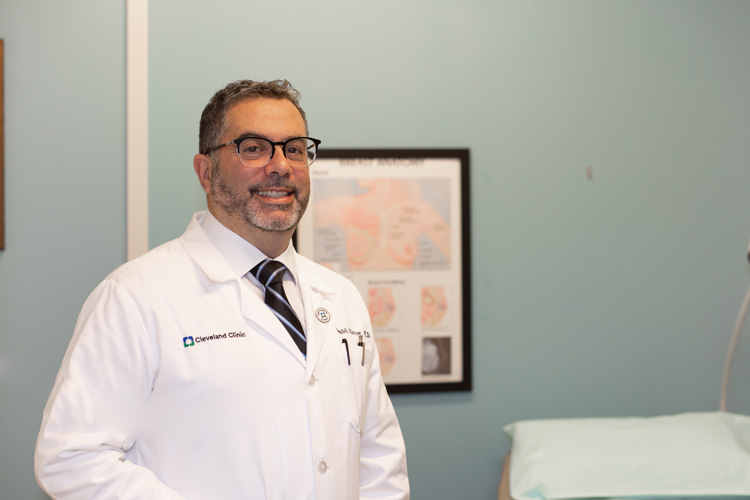October is now long gone and with it went the pink shoes on NFL football players, the seemingly endless TV ads for car dealers offering pink license-plate holders and all the other hoopla associated with Breast Cancer Awareness Month.
Now it’s time to get down to the nuts and bolts of breast cancer surgery with Cleveland Clinic Indian River Hospital’s Dr. Daniel Glotzer.
Though Glotzer’s business card calls him a “general surgeon,” his own, personal experience with breast cancer is about as specific as it gets.
“My wife is a breast cancer survivor” says Glotzer. “We were married for six months when we wanted to begin to put a family together so she goes through her checklist: ‘I’ve got to get my mammogram, my Pap smear,’ and so on.
“And when they did the mammogram, she showed me the film and it was like … well … she saw my face. I didn’t have to say anything. And that was 18 years ago.
“So, I have a special interest in cancer, particularly in breast cancer, and I’ve been very active with the American Cancer Society here in town.”
Outside of skin cancer, breast cancer is the most commonly diagnosed cancer among women in this country and, yes, it is a disease that can also strike men.
According to BreastCancer.org, about one in eight American women will develop invasive breast cancer at some point and just this year an estimated 268,600 new cases of invasive breast cancer are expected to be diagnosed in women in the U.S. along with 62,930 new cases of non-invasive (in situ) breast cancer.
Meanwhile, about 2,670 new cases of invasive breast cancer are expected to be diagnosed in American men in 2019.
Still, according to Glotzer, “the good news is that because of our aggressive screening and good treatment, we can say [breast cancer] becomes more of a chronic disease or a chronic issue than actually an acute healthcare problem.”
That all starts with screenings.
“The current recommendations,” says Glotzer, “are to consider a mammogram starting at the age of 40, but certainly to start yearly mammograms from age 45 to 54.” After age 55, Glotzer says woman can dial back and “do it every two years.”
However, “people who have a history of early breast cancer in their family should start mammograms earlier. If mom or dad or grandma had breast cancer when they were in their 40s or 30s, those people should start mammograms at the age of 30.”
Glotzer says that here in Vero there are outstanding imaging options, including tomosynthesis or 3D mammography as well as high-definition ultrasound and MRIs.
That’s a major advance from the early days of breast cancer screening and there has been even more pronounced improvement in the surgeries employed when screening reveals cancer.
Glotzer rattles off a sometimes-gruesome history of the surgical procedures used to treat breast cancer, including one that removed not only the entire breast but also all the muscles on that side of the chest as well.
It wasn’t until the 1972, Glotzer points out, that Dr. John Madden introduced what we now know as “the modified radical mastectomy,” which preserves the pectoral muscles.
Today, says the Susan G. Komen Foundation, mastectomies (total removal of the breast) and lumpectomies (a “breast conservation” approach) are the two most commonly used procedures.
Another change is that more medical professionals are involved in the decision-making process ahead of surgery now than years ago.
“Here”, says Glotzer, “we have a tumor board that meets every month on every breast cancer case that is newly diagnosed in our community. It’s a multidisciplinary approach in that you have the surgeons, the medical oncologists, the plastic surgeons, the radiation oncologists and the nurses” conferring to decide the best course of treatment to recommend to a patient.
In addition to himself, Glotzer says Drs. Murphy, Perry and Paul “all do local breast cancer surgeries.
“In this community,” Glotzer continues, “the most commonly performed procedure probably is what we would call a partial mastectomy. Most people call that procedure a ‘lumpectomy.’”
That’s because, as Glotzer puts it, “no woman should feel that you have to give up your breast to live longer.”
The American Cancer Society says “some women might worry that having a less extensive surgery might raise their risk of the cancer coming back. But studies following thousands of women for more than 20 years show that when breast conservation surgery is done with radiation, survival is the same as having a mastectomy in people who are candidates for both types of surgery.”
The bottom line: The best defense against breast cancer is to have regular checkups with your primary care doctor and annual mammogram to catch the disease in its earliest stages.
Dr. Daniel Glotzer is a general surgeon at the Cleveland Clinic Indian River Hospital. His office is at 3450 11th Court, Suite 204. The phone number is 772-770-6850.

